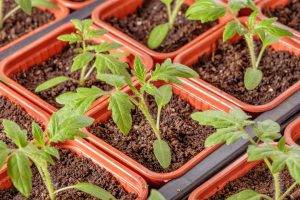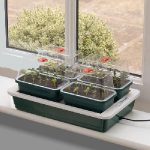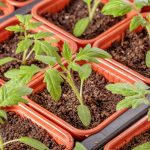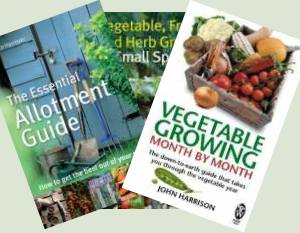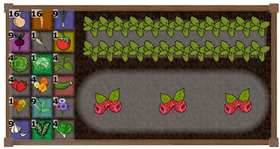What is the ideal temperature for seed germination is a simple question but the answer is actually quite complicated.
Most seeds will germinate over quite a wide range of soil temperatures but the speed of germination will vary. Too cold and they’ll be very slow to sprout and too hot will also reduce the speed of germination. Far too cold or hot and they’ll just fail.
Academic research carried out in the USA has charted these temperature ranges for a number of vegetables. Interestingly the ideal temperature for germination is often far higher than you might expect. In some cases the germination temperature is higher than is ideal for growing.
Temperature for Tomato Germination
A good example of this is the tomato. Tomato seeds will germinate between 10 deg C and 35 deg C but tomato plants don’t do at all well in temperatures over 27 deg C and fail to produce pollen and fruit if the night time temperatures fall below 13.5 deg C. Yet the ideal temperature for germination of tomatoes is 29 deg C
In practice you would most likely germinate your tomatoes with a soil temperature between 20 deg C and 25 deg C which is fairly easy to achieve in a heated propagator.
Curiously carrots’ ideal germination temperature is 27 deg C – I can’t imagine the soil in the UK hits that high often, if at all! The optimum range for carrots is between 7 deg C and 29 deg C with far faster germination rates once the soil hits 10 deg C.
Since carrots are invariably direct sown, knowing your soil temperature will enable you to know when you can sow and expect reasonable germination rates and speed. You can warm up the soil outside by a few degrees if you cover it with horticultural fleece or better still use a cloche which can make a surprising difference to germination rates and times.
A very old method of getting a warm soil to sow in is to use a hot bed cased in fine soil. Not much use for root crops like carrots and parsnips but any crop that can be transplanted will benefit from the bottom heat.
A few points to keep in mind:
- The temperatures quoted are soil or compost temperature, not air temperature. A sunny day in April may be 20ºC but the soil temperature is most likely stuck around 8ºC.
- A soil thermometer can be bought very cheaply, typically less than £10.00, which will give you an accurate figure to work from
- Beware the sunny day when propagating in the greenhouse. Temperatures can soar, basically cooking your seeds or seedlings.
Germination Temperature Charts
The charts have been compiled from a number of academic studies. There are some differences due to differences in methods between studies but I think they’re a fair guide.
Seeds will germinate across a wide range of temperatures but as the temperature falls below the optimum range the length of time it takes for them to germinate increases and the percentage germination rate falls. Long germination times also makes the seeds more vulnerable to disease.
The first chart gives the minimum and maximum temperatures at which seeds will germinate. However, as the chart below – seed germination time against temperature shows, with onions at 1ºC the germination period (about 4 months) would be so long that most of us would have given up!
The best temperatures for seed germination are in the last chart.
| Variety | Min to Max Temp |
|---|---|
| Aubergine | 16 to 35 |
| Beans Broad | 6 to 28 |
| Beans French | 8 to 35 |
| Beans Runner | 8 to 35 |
| Beet | 6 to 35 |
| Cabbage | 6 to 30 |
| Carrot | 6 to 35 |
| Cauliflower | 6 to 30 |
| Courgettes | 16 to 35 |
| Swiss-Chard | 6 to 35 |
| Sweetcorn | 10 to 40 |
| Cucumber | 16 to 40 |
| Lettuce | 2 to 35 |
| Onion | 1 to 35 |
| Parsley | 6 to 32 |
| Parsnip | 2 to 29 |
| Pea | 6 to 29 |
| Sweet Peppers & Chillies | 16 to 35 |
| Radish | 6 to 35 |
| Spinach | 2 to 29 |
| Squash & Pumpkins | 16 to 38 |
| Tomato | 10 to 35 |
| Turnip & Swede | 6 to 40 |
Percentage Germination of Seeds and Time to Seedling Emergence at Different Temperatures
| Temp. Deg. C |
% Germination |
Days to Seedling Emergence |
|---|---|---|
| 0 | 90 | 136 |
| 5 | 98 | 31 |
| 10 | 98 | 13 |
| 15 | 98 | 7 |
| 20 | 98 | 5 |
| 25 | 97 | 4 |
| 30 | 91 | 4 |
| 35 | 73 | 13 |
| 40 | 2 | 13 |
| Temp. Deg. C |
% Germination |
Days to Seedling Emergence |
|---|---|---|
| 0 | 0 | N/A |
| 5 | 0 | N/A |
| 10 | 47 | 22 |
| 15 | 97 | 12 |
| 20 | 97 | 7 |
| 25 | 98 | 7 |
| 30 | 91 | 4 |
| 35 | 88 | 3 |
| 40 | 10 | 3 |
Best Temperatures for Seed Germination
As you can see from the charts above for Sweetcorn and Onion Germination, there is a sweet spot where there is high germination in a short time but a temperature a few degrees above or below makes little difference.
There are also variations between batches of seed and varieties, so rather than lay down a single temperature, it’s best to look at a range of temperatures where you can expect reasonable levels of germination.
| Variety | Min to Max Opt. Temp |
|---|---|
| Aubergine | 24 to 32 |
| Beans Broad | 8 to 15 |
| Beans French | 15 to 30 |
| Beans Runner | 15 to 25 |
| Beet | 10 to 25 |
| Cabbage | 10 to 25 |
| Carrot | 10 to 35 |
| Cauliflower | 10 to 25 |
| Courgettes | 20 to 35 |
| Swiss-Chard | 10 to 25 |
| Sweetcorn | 15 to 30 |
| Cucumber | 15 to 35 |
| Lettuce | 5 to 25 |
| Onion | 10 to 25 |
| Parsley | 10 to 28 |
| Parsnip | 15 to 20 |
| Pea | 10 to 25 |
| Sweet Peppers & Chillies | 20 to 30 |
| Radish | 15 to 30 |
| Spinach | 5 to 15 |
| Squash & Pumpkins | 20 to 30 |
| Tomato | 15 to 25 |
| Turnip & Swede | 15 to 35 |
Armed with this knowledge you can better judge when to sow outside and what temperature to set a propagator at for good germination.
However, keep in mind that not all plants will thrive after germination at the higher temperatures of the optimum range for germination.
Onions are best started at 15ºC or even 10ºC and even heat loving crops like tomatoes will do better if the temperature is dropped on or just prior to seedling emergence to 20ºC

